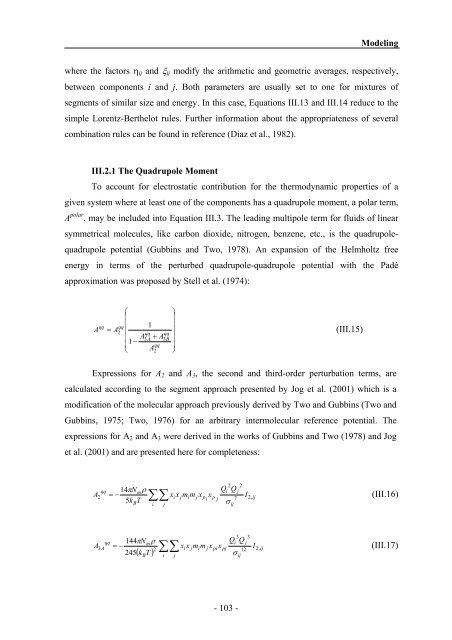n - PATh :.: Process and Product Applied Thermodynamics research ...
n - PATh :.: Process and Product Applied Thermodynamics research ...
n - PATh :.: Process and Product Applied Thermodynamics research ...
You also want an ePaper? Increase the reach of your titles
YUMPU automatically turns print PDFs into web optimized ePapers that Google loves.
Modeling<br />
where the factors ηij <strong>and</strong> ξij modify the arithmetic <strong>and</strong> geometric averages, respectively,<br />
between components i <strong>and</strong> j. Both parameters are usually set to one for mixtures of<br />
segments of similar size <strong>and</strong> energy. In this case, Equations III.13 <strong>and</strong> III.14 reduce to the<br />
simple Lorentz-Berthelot rules. Further information about the appropriateness of several<br />
combination rules can be found in reference (Diaz et al., 1982).<br />
III.2.1 The Quadrupole Moment<br />
To account for electrostatic contribution for the thermodynamic properties of a<br />
given system where at least one of the components has a quadrupole moment, a polar term,<br />
A polar , may be included into Equation III.3. The leading multipole term for fluids of linear<br />
symmetrical molecules, like carbon dioxide, nitrogen, benzene, etc., is the quadrupole-<br />
quadrupole potential (Gubbins <strong>and</strong> Two, 1978). An expansion of the Helmholtz free<br />
energy in terms of the perturbed quadrupole-quadrupole potential with the Padé<br />
approximation was proposed by Stell et al. (1974):<br />
A<br />
qq<br />
= A<br />
qq<br />
2<br />
⎛<br />
⎜<br />
⎜ 1<br />
⎜ qq<br />
⎜ A3<br />
A + A<br />
1−<br />
⎜<br />
qq<br />
⎝ A2<br />
qq<br />
3B<br />
⎞<br />
⎟<br />
⎟<br />
⎟<br />
⎟<br />
⎟<br />
⎠<br />
(III.15)<br />
Expressions for A2 <strong>and</strong> A3, the second <strong>and</strong> third-order perturbation terms, are<br />
calculated according to the segment approach presented by Jog et al. (2001) which is a<br />
modification of the molecular approach previously derived by Two <strong>and</strong> Gubbins (Two <strong>and</strong><br />
Gubbins, 1975; Two, 1976) for an arbitrary intermolecular reference potential. The<br />
expressions for A2 <strong>and</strong> A3 were derived in the works of Gubbins <strong>and</strong> Two (1978) <strong>and</strong> Jog<br />
et al. (2001) <strong>and</strong> are presented here for completeness:<br />
2 2<br />
qq 14πN<br />
mρ<br />
Qi<br />
Q j<br />
A 2 = − ∑∑xi<br />
x jmi<br />
m j x p x<br />
i p I<br />
j 7 2,<br />
ij<br />
5kBT<br />
i j<br />
σ ij<br />
( ) ∑∑<br />
3 3<br />
qq 144πN<br />
mρ<br />
Qi<br />
Q j<br />
A 3A<br />
= −<br />
xi<br />
x jmi<br />
m j x pix<br />
pj I<br />
2<br />
12 2,<br />
ij<br />
245 kBT<br />
i j<br />
σ ij<br />
- 103 -<br />
(III.16)<br />
(III.17)



